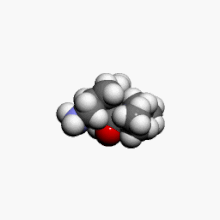|
Milnacipran
Milnacipran![]() |  | |
| Prodajno ime | Dalcipran, Ixel, Savella, Toledomin |
|---|
| Drugs.com | Monografija |
|---|
| Način primene | Oralno |
|---|
|
| Poluvreme eliminacije | 6-8 sati |
|---|
| Izlučivanje | Urinom (50%- 60%, 24% kao l-milnacipran i 31% kao d-milnacipran) |
|---|
|
|
|---|
|
| CAS broj | 92623-85-3  Y Y |
|---|
| ATC kod | N06AX17 (WHO) |
|---|
| PubChem | CID 65833 |
|---|
| DrugBank | DB04896  Y Y |
|---|
| ChemSpider | 59245  Y Y |
|---|
| ChEMBL | CHEMBL252923  Y Y |
|---|
|
| Formula | C15H22N2O |
|---|
| Molarna masa | 246,348 |
|---|
CCN(CC)C(=O)[C@@]1(C[C@@H]1CN)C1=CC=CC=C1
|
InChI=1S/C15H22N2O/c1-3-17(4-2)14(18)15(10-13(15)11-16)12-8-6-5-7-9-12/h5-9,13H,3-4,10-11,16H2,1-2H3/t13-,15+/m1/s1  Y YKey:GJJFMKBJSRMPLA-HIFRSBDPSA-N  Y Y
| |
|
|---|
|
| Tačka topljenja | 179 °C (354 °F) |
|---|
|
|
|---|
Milnacipran je organsko jedinjenje, koje sadrži 15 atoma ugljenika i ima molekulsku masu od 246,348 Da.[1][2][3][4][5][6][7][8][9][10][11][12][13][14][15]
Osobine
Reference
- ^ Leo RJ, Brooks VL (јул 2006). „Clinical potential of milnacipran, a serotonin and norepinephrine reuptake inhibitor, in pain”. Curr Opin Investig Drugs. 7 (7): 637—42. PMID 16869117.
- ^ Sato S, Yamakawa Y, Terashima Y, Ohta H, Asada T (октобар 2006). „Efficacy of milnacipran on cognitive dysfunction with post-stroke depression: preliminary open-label study”. Psychiatry Clin Neurosci. 60 (5): 584—9. PMID 16958942.
- ^ Simon, L. S. (март 2006). „Is milnacipran effective in treating pain in patients with fibromyalgia?”. Nature Clinical Practice. Rheumatology. 2 (3): 126—7. PMID 16932669. doi:10.1038/ncprheum0135.
- ^ Soya A, Terao T, Nakajima M, Kojima H, Okamoto T, Inoue Y, Iwakawa M, Shinkai K, Yoshimura R, Ueta Y, Nakamura J. „Effects of repeated milnacipran administration on brain serotonergic and noradrenergic functions in healthy volunteers”. 187 (4). септембар 2006: 526—7. PMID 16830129. . Epub 2006 Jul 8. .
- ^ King T, Rao S, Vanderah T, Chen Q, Vardanyan A, Porreca F (јул 2006). „Differential blockade of nerve injury-induced shift in weight bearing and thermal and tactile hypersensitivity by milnacipran”. J Pain. 7 (7): 513—20. PMID 16814690.
- ^ Moojen VK, Martins MR, Reinke A, Feier G, Agostinho FR, Cechin EM, Quevedo J. „Effects of milnacipran in animal models of anxiety and memory”. Neurochem Res. 31 (4): 571—7. април 2006. PMID 16758367. . Epub 2006 May 9. .
- ^ Moret C, Charveron M, Finberg JP, Couzinier JP, Briley M (децембар 1985). „Biochemical profile of midalcipran (F 2207), 1-phenyl-1-diethyl-aminocarbonyl-2-aminomethyl-cyclopropane (Z) hydrochloride, a potential fourth generation antidepressant drug”. Neuropharmacology. 24 (12): 1211—9. PMID 3005901.
- ^ Briley M, Prost JF, Moret C (септембар 1996). „Preclinical pharmacology of milnacipran”. Int Clin Psychopharmacol. 11 (4): 9—14. PMID 8923122.
- ^ Puozzo C, Panconi E, Deprez D (јун 2002). „Pharmacology and pharmacokinetics of milnacipran”. Int Clin Psychopharmacol. 17 (1): S25—35. PMID 12369608.
- ^ Leinonen E, Lepola U, Koponen H, Mehtonen OP, Rimon R (децембар 1997). „Long-term efficacy and safety of milnacipran compared to clomipramine in patients with major depression”. Acta Psychiatr Scand. 96 (6): 497—504. PMID 9421348.
- ^ Papakostas GI, Fava M. „A meta-analysis of clinical trials comparing milnacipran, a serotonin--norepinephrine reuptake inhibitor, with a selective serotonin reuptake inhibitor for the treatment of major depressive disorder”. Eur Neuropsychopharmacol. 17 (1): 32—6. јануар 2007. PMID 16762534. . Epub 2006 Jun 8. .
- ^ Kako Y, Niwa Y, Toyomaki A, Yamanaka H, Kitagawa N, Denda K, Koyama T. „A case of adult attention-deficit/hyperactivity disorder alleviated by milnacipran”. Prog Neuropsychopharmacol Biol Psychiatry. 31 (3): 772—5. април 2007. PMID 17300859. . Epub 2007 Jan 12. .
- ^ Bernstein, C. D.; Albrecht, K. L.; Marcus, D. A. (2013). „Milnacipran for fibromyalgia: A useful addition to the treatment armamentarium”. Expert Opinion on Pharmacotherapy. 14 (7): 905—916. PMID 23506481. doi:10.1517/14656566.2013.779670.
- ^ Knox, C.; Law, V.; Jewison, T.; Liu, P.; Ly, S.; Frolkis, A.; Pon, A.; Banco, K.; Mak, C.; Neveu, V.; Djoumbou, Y.; Eisner, R.; Guo, A. C.; Wishart, D. S. (2011). „DrugBank 3.0: A comprehensive resource for 'omics' research on drugs”. Nucleic Acids Research. 39 (Database issue): D1035—41. PMC 3013709
 . PMID 21059682. doi:10.1093/nar/gkq1126. . PMID 21059682. doi:10.1093/nar/gkq1126.
- ^ Wishart, D. S.; Knox, C.; Guo, A. C.; Cheng, D.; Shrivastava, S.; Tzur, D.; Gautam, B.; Hassanali, M. (2008). „DrugBank: A knowledgebase for drugs, drug actions and drug targets”. Nucleic Acids Research. 36 (Database issue): D901—6. PMC 2238889
 . PMID 18048412. doi:10.1093/nar/gkm958. . PMID 18048412. doi:10.1093/nar/gkm958.
- ^ Ghose, Arup K.; Viswanadhan, Vellarkad N.; Wendoloski, John J. (1998). „Prediction of Hydrophobic (Lipophilic) Properties of Small Organic Molecules Using Fragmental Methods: An Analysis of ALOGP and CLOGP Methods”. The Journal of Physical Chemistry A. 102 (21): 3762—3772. Bibcode:1998JPCA..102.3762G. doi:10.1021/jp980230o.
- ^ Tetko, I. V.; Tanchuk, V. Y.; Kasheva, T. N.; Villa, A. E. (2001). „Estimation of aqueous solubility of chemical compounds using E-state indices”. Journal of Chemical Information and Computer Sciences. 41 (6): 1488—1493. PMID 11749573. doi:10.1021/ci000392t.
- ^ Ertl, P.; Rohde, B.; Selzer, P. (2000). „Fast calculation of molecular polar surface area as a sum of fragment-based contributions and its application to the prediction of drug transport properties”. Journal of Medicinal Chemistry. 43 (20): 3714—3717. PMID 11020286. doi:10.1021/jm000942e.
Literatura
Spoljašnje veze
 | Molimo Vas, obratite pažnju na važno upozorenje
u vezi sa temama iz oblasti medicine (zdravlja). |
|
|